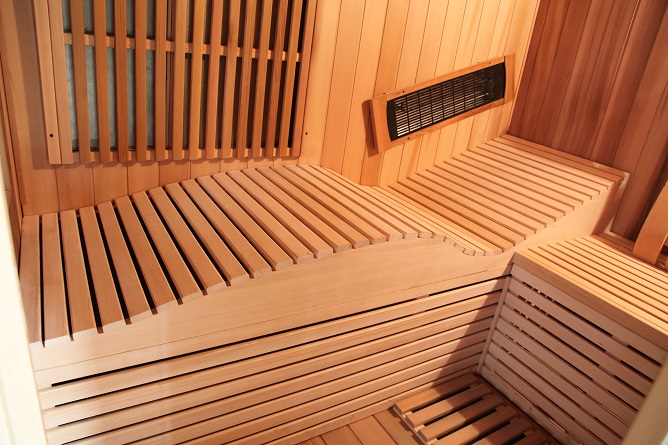Sauna Benefits: The Advantages of an Infrared Sauna


An infrared cabin has numerous sauna benefits compared to a traditional sauna. In addition to its practicality, the health benefits and therapeutic effects of infrared sauna use are well established. Below, we explain these advantages in greater detail.
Pain Relief for Chronic Muscle and Joint Problems
The most significant difference between a traditional sauna and an infrared sauna is the deep-penetrating infrared heat, which offers excellent pain relief for those suffering from chronic pain, arthritis, or other musculoskeletal issues. Unlike dry heat, infrared lamps warm the body directly, stimulating blood flow and loosening stiff joints. This makes infrared sauna bathing particularly beneficial for people with chronic pain or conditions such as rheumatism and osteoarthritis.
Doctors often recommend infrared therapy as part of a pain management routine, especially because it helps reduce stress on the joints and promotes muscle recovery. Infrared sauna sessions can also help reduce muscle soreness and stiffness following exercise.


Effective Detoxification with Infrared Heat
Infrared radiation stimulates the body’s natural detoxification process. Users start sweating soon after entering the sauna, which helps initiate the detoxification process. During a sweat session, your body starts releasing toxins through the skin, resulting in a deep cleanse. Regular sauna use increases your metabolic rate, supporting your body’s detox pathways. This is why institutes like the Hippocrates Health Institute in Florida integrate infrared sauna sessions into their detox programs.
One of the many health benefits of using an infrared sauna is its ability to aid the immune system and support cardiovascular health through detoxification.


Skin Conditions: Relief and Healing
Frequent use of an infrared sauna can significantly improve skin conditions such as eczema, psoriasis, and acne. The infrared heat stimulates blood circulation, increases oxygenation in tissues, and promotes cell regeneration. Sweating helps to remove toxins and clear the skin, reducing inflammation and irritation.
This makes infrared cabins a compelling option for people with persistent skin issues seeking a natural solution.
Faster Warm-Up Time and High Convenience
A traditional sauna typically takes 45–60 minutes to heat up, while an infrared sauna reaches optimal temperature within 5–10 minutes. This not only saves time but also energy.
Because infrared saunas are typically heated using radiant heat and not ambient air temperature, they offer a more efficient and quicker start to your sauna session.
Energy Efficiency and Easy Installation
Unlike a wood-burning or electrically powered dry sauna, most infrared saunas operate on standard 220V power and use between 1100–3000 watts. This makes them cheaper to run and much easier to install, without needing special wiring.
Infrared saunas are generally safe and cost-effective, with annual operating costs as low as £24,65 for twice-weekly sessions.
Simple Usage and Time-Efficient
A complete infrared sauna session can be completed within 30–60 minutes, including warm-up. Even a single session of infrared sauna can offer noticeable relaxation and wellness benefits. This contrasts with a traditional sauna, which may require several hours for a full session.
For people with a busy lifestyle, this efficiency makes regular sauna use far more feasible.
Flexible Placement and Compact Design
Infrared saunas are typically more compact and lighter than traditional saunas, which require larger space and heavier construction. A 2-person infrared cabin can measure as little as 110cm x 100cm, making it suitable for most homes.
Their modular design means they are easy to assemble and can be placed in rooms with carpet or laminate flooring.


Easy and Fast Assembly
Infrared cabins use a panel click system and can be assembled within 40 to 60 minutes. There's no need for professional electrical installation, unlike a traditional sauna, which often requires a certified electrician.
This makes them ideal for home use and renters alike.
Sauna Use and Cardiovascular Benefits
Studies suggest that sauna bathing, especially with regular sauna use, contributes to better cardiovascular health. The increased heart rate, improved blood flow, and lowered blood pressure during infrared sessions help maintain vascular function. Sauna bathing helps reduce blood pressure by promoting relaxation of blood vessels and improving their function. Sauna exposure activates the autonomic nervous system, which plays a key role in cardiovascular regulation and stress adaptation. Studies also show that using a sauna at least four times a week is associated with greater cardiovascular benefits and a reduced risk of heart-related events. Some research even links regular sauna exposure to reduced risks of heart failure, high blood pressure, and cardiovascular disease.
These potential health benefits make infrared saunas a valuable addition to a heart-healthy lifestyle.
Immune System Function
Regular use of an infrared sauna may play a supportive role in strengthening the immune system. The gentle heat generated during sauna bathing can stimulate the body’s natural defenses by increasing the production of white blood cells, which are essential for fighting off infections and maintaining overall health. As your body heats up during an infrared sauna session, the induced sweating helps flush out toxins, further supporting immune system function. Some studies have found that people who incorporate regular sauna sessions into their routines experience fewer common colds and other minor illnesses. While more research is needed to fully understand the connection between infrared sauna use and immune health, the available evidence suggests that making sauna use a consistent part of your wellness routine could contribute to a stronger, more resilient body.
Mental and Neurological Health
While more research is needed, preliminary studies suggest a possible link between regular sauna use and a reduced risk of dementia and Alzheimer’s disease. Infrared heat also supports mental health by promoting relaxation, better sleep, and reducing too much stress.
Using a sauna consistently may offer both physical and mental health advantages.
Comparison to Traditional Saunas
Infrared saunas and traditional saunas offer distinct experiences and benefits due to their different heating methods. There are a few differences between infrared saunas and traditional saunas. Traditional saunas rely on dry heat to warm the air, which then heats the body indirectly, often resulting in higher air temperatures. In contrast, infrared saunas use infrared lamps to heat the body directly, allowing for effective sauna sessions at lower temperatures. This makes infrared saunas more comfortable for those who may find the intense heat of traditional saunas overwhelming. Both types of saunas are associated with health benefits such as improved cardiovascular health, pain relief, and enhanced mental health. However, some research suggests that infrared saunas may be particularly effective at reducing blood pressure and supporting cardiovascular function, thanks to the deeper penetration of infrared heat into the body. Ultimately, the choice between an infrared sauna and a traditional sauna depends on personal preferences, comfort levels, and specific health goals.
Safety Precautions and Considerations
While infrared sauna use is generally safe for most people, it’s important to be mindful of certain safety precautions to ensure a positive experience. One of the biggest risks associated with infrared sauna sessions is dehydration, so it’s essential to drink plenty of water before, during, and after your sweat session. Pay close attention to how your body feels—if you experience dizziness, lightheadedness, or muscle cramps, it’s best to exit the sauna immediately. Individuals with medical conditions such as high blood pressure, heart failure, or dementia and Alzheimer’s disease should consult their primary care physician before beginning infrared sauna use. Additionally, avoid drinking alcohol before or after your sauna session, as it can increase the risk of dehydration and other adverse effects. By following these guidelines and listening to your body, you can enjoy the many health benefits of infrared sauna use while minimizing potential risks.
Conclusion
In summary, infrared saunas provide a wide range of health benefits, from supporting cardiovascular health and pain relief to enhancing mental health and immune system function. While they differ from traditional saunas in their heating method and operating temperature, infrared saunas offer a comfortable, accessible, and effective way to improve overall well-being. By understanding and following safety precautions, users can maximize the positive effects of sauna use and reduce potential risks. Whether you’re seeking to reduce stress, achieve better sleep, or simply enjoy the relaxing heat and low humidity, incorporating infrared sauna sessions into your routine can be a valuable step toward better health. With their proven benefits and user-friendly design, infrared saunas are an excellent choice for anyone looking to invest in their health and quality of life.
Bronnen
https://www.ahajournals.org/doi/10.1161/str.45.suppl_1.tmp94
https://www.heart.org/en/health-topics/heart-failure/what-is-heart-failure/classes-of-heart-failure
https://www.ucsfhealth.org/conditions/heart_failure/treatment.html
https://www.ncbi.nlm.nih.gov/pmc/articles/PMC5873965/
https://www.ncbi.nlm.nih.gov/pubmed/19602651
https://www.healthline.com/health/vasodilation#causes
https://www.ncbi.nlm.nih.gov/pmc/articles/PMC4961993/
https://www.mayoclinic.org/diseases-conditions/heart-failure/diagnosis-treatment/drc-20373148





